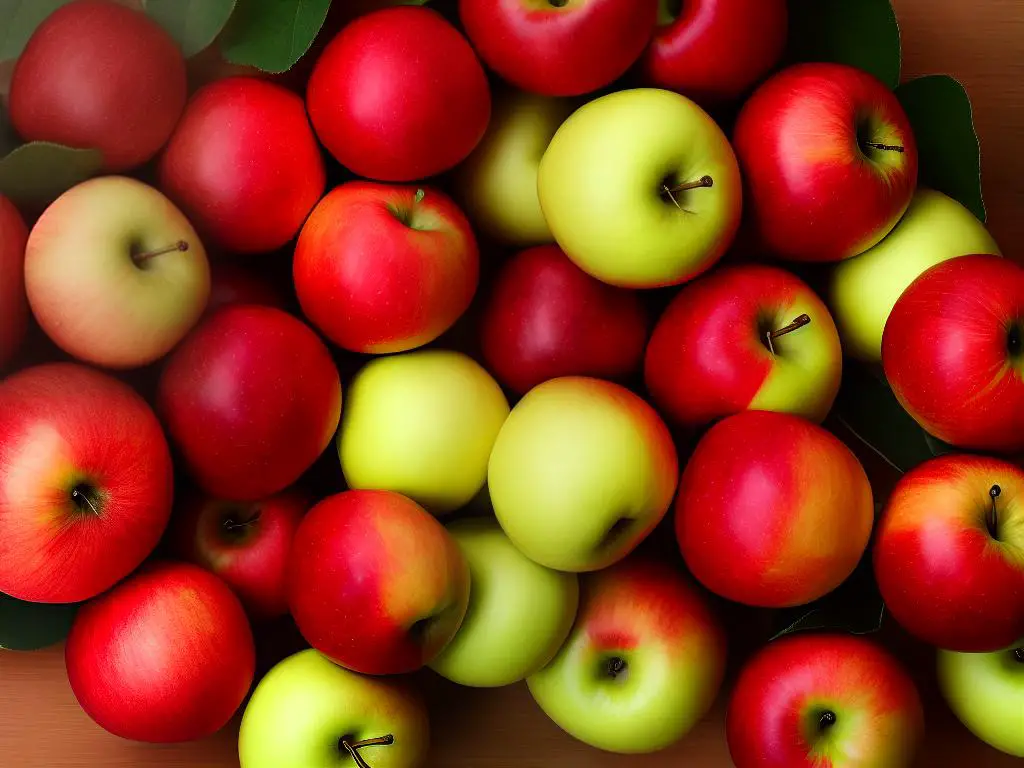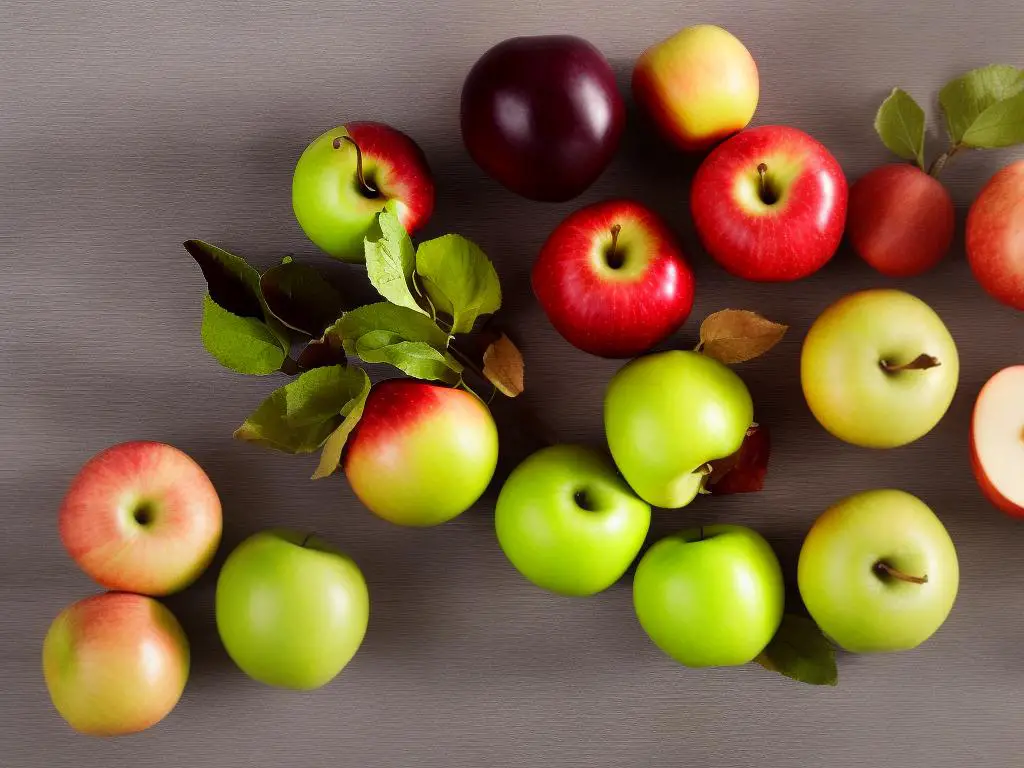Apples are undoubtedly one of the most popular fruits worldwide, not only because of their sweet, tangy taste, but also because of their remarkable health benefits. While most of us simply enjoy the fruit and savor its taste, few give much consideration to the variety in apple sizes and the factors that influence these dimensions. However, the size of apple fruits varies dramatically, influenced by elements such as variety, climate, and soil type. Beyond this, apple sizes carry different implications in relation to agricultural practices, environmental sustainability, and even the health benefits they present. This discourse takes a deeper dive into understanding the different sizes of apple fruits, the significance of these sizes, and how these sizes are measured and graded within the industry.
Different Sizes of Apple Fruit
Understanding the Size Spectrum of Apples
Apples, a common sight in grocery stores, come in diverse colors and sizes. This size range isn’t merely a consequence of haphazard growth; various factors intertwine to create an apple’s final size.
The Factors That Determine Size
Not all apple varieties are created equal — some are naturally larger than others. For instance, a Bramley apple is generally much larger than a Lady apple.
However, genetics aren’t the only factor in determining an apple’s size. An array of external influences can also make a large difference.
The local climate, for example, heavily influences the size of an apple. Sunlight, rain, and the chill of autumn all contribute to the growth and ultimate size of the fruit.
Soil conditions also play an important role. Nutrient-rich, well-drained soil fosters growth while poor soil can limit an apple’s size potential.
Horticultural practices command significant authority over apple size too. Regular pruning and thinning methods allow the remaining fruits to grow larger, devoid of competition for resources.
Genetics’ Role in Size
Regardless of the environmental factors, genetics seal an apple’s size potential within its DNA. An apple’s genetic blueprint determines its potential for growth, barring extraordinary circumstances.
These genetic differences, passed down through generations, predicate the size diversity of apples. Much like humans come in all shapes and sizes, so do apples.
Implication of Apple Fruit Sizes
The Variety in Apple Sizes
Reflecting the diversity born from the myriad species, apple sizes range from large to small, with each size category carrying its own set of implications. Whether they are the massive fruits that seem to embody the sun’s energy or the understated ones barely visible beneath the leaves, all apples contribute to the vast tapestry of life, providing more than just a crisp bite to eat.
Taste and Nutrient Vary with Size
Small apples seem shy when juxtaposed against the bulging, boastful larger ones, but they’re not absentees in existence, nor do they shy away gracing every bite with the same burst of flavor. Possibly, how one might argue, it’s the size that walks hand-in-hand with that factor profoundly influencing the taste – sugar content. Minuscule apples often pack a punch in terms of the sugar content, making them sweeter. The split verdict among consumers on preference for either majestically sweet or subtly sour is the jury still in session.
Nutrient content, paramount to the healthful profile of apples, seems to roller-coaster across the size spectrum. An interesting trend observed is that of comparatively higher amount of essential nutrients – vitamins and minerals, clinging onto larger counterparts. Amplified skin-to-flesh ratio perhaps forecasts health merits of smaller apples, given that the skin is where antioxidants, dietary fiber and flavonoids sway in abundance.
Apple Size and Commercial Value
The commercial realm bows to the magnificence of larger apples, propelled by the fixed, unchanging mold by which consumer preferences are structured. Giant apples, polished to a glaring shine, often christen the top shelves, commanding a higher price. An apple’s size spins the wheel of its commercial journey, setting the sail from harvest to packaging, its travel down transportation lanes till it adorns baskets, or graces dining tables. Smaller apples, though bear equally the charm of freshness, unfortunately, often lose out.
Environmental Footprint and Apple Size
Agri-environmental sustainability plays the fiddles as size of apple juggles up or down. Smaller apples, lesser resource-demanding and thereby eco-friendlier heroes, could teleport us into a future where environmental footprint shrinks without compromising on yield. On the contrary, the unanimous applause larger apples receive ramp up their production. However, this adds significant weight to the environmental footprint, fueling input demands – water, fertilizers, and not to forget, the expanded storage space.
Health Implications of Apple Size
Does every bite into the ‘an apple a day’ health mantra, depending on it being large or small, bear unequal health implications? Contrasting perspectives are penned down in health annals. Smaller apples, with their raised skin percent, tap the potential for enhanced health benefits. Larger ones, though lead with decreased skin fraction, possibly hint towards greater satiety, given the increased serving size. It’s astounding how size weaves the fate, not just for apples themselves, but also for us, the ones they nourish and nurture.
Apples, from exceedingly large to remarkably small, each showcase their unique size with glory, impacting various aspects of life. Be it agriculture, environmental considerations, market economics, or human health, the different sizes of apples hold a weighty significance. The adage, ‘Great things come in small packages, and bigger isn’t always better.’ couldn’t have held more truth. Each size, whether small or large, carries its own narrative, its own appeal, and its own meaningful place in existence.

Measuring and Grading Apple Fruit Sizes
Experience in the Apple Orchards
The season may have been lost in the fog of time, but the memory of a visit to the apple orchard still shines bright. It was there, under the tree canopies heavy with apples, that I came to appreciate the importance of apple sizes.
Apple growers, who carry the story of the soil on their hands and the map of the sun in their eyes, have perfected the art of measuring and grading the apples. The tools they use are humble yet effective, could be anything from handheld calipers to skillfully crafted sizing rings. These tools provide them with a numerical specification based on diameter, essential information for both the growers and supply chain.
In the Hands of Experts
The grower’s eyes, seasoned by years of apple cultivation, have a unique precision. Just a glance can usually give them size category, but nothing beats the confirmation of an actual measurement. Like artisan jewelers assessing the cut and clarity of an undressed diamond, apple growers ascertain the apple’s grade with strict meticulousness.
They work quietly but methodically, assessing every fruit for its size. The larger the diameter, the higher the grade it gets. Industry standards are painstakingly adhered to, ensuring that the size ‘large’ remains consistent across orchards and markets.
Not Just a Matter of Diameter
However, the complexity doesn’t stop with measuring the diameter. There is an art to it, a science even. As apples grow and mature, they do not necessarily maintain a perfect spherical shape. Many factors, such as variety, climate, and growing conditions, influence the final form that these fruits bring to the table.
Therefore, growers also consider the fruit’s vertical height and cheek width as additional indicators of size. All these dimensional nuances unfold in a subtle ballet, creating a spectrum of apple sizes, each size catered to a different consumer preference.
The Consumer’s Compass
Regardless of the day or season, you will find shoppers crowding the apple sections of supermarkets, meticulously selecting the choicest of apples with an almost reverential scrutiny. You may think they are just checking for freshness, but conscious shoppers also use apple sizes as a guideline for their purchasing decisions.
Smaller apples, perfect for tucking in lunchboxes or munching on-the-go, are preferred by the health-conscious and the time-pressed. Larger ones, with their generous volume and striking visibility, make a compelling choice for festive arrangements and culinary endeavors.
There’s a size of apple for each lifestyle, each occasion, each palate. And understanding this nuanced landscape of apple sizes is a voyage, an exploration into the heart of this humble fruit’s journey from the orchard to our tables. The size of an apple may seem but a small matter. Yet, in it unfolds the story of the fruit’s growth, the farmer’s care, and our gastronomic gratification.

Delving into the intricacies of apple sizes reveals a whole new level of appreciation for this common fruit. Recognizing how the different sizes come about, their various implications, and how they are measured and graded by industry standards serves not only to educate but also guides consumer decisions. In the realm of agriculture, the environment, and health, the size of an apple takes on unique perspectives, each with its own importance. So, the next time you pick an apple, remember, there’s more to its size than meets the eye. It is a reflection of the fruit’s variety, the conditions of its growth, what it represents for our environment, and the potential health benefits we could derive from it.
